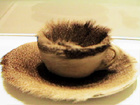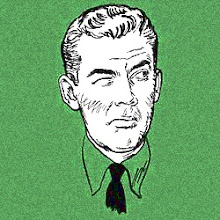 e. e. cummings got really famous in the 1950s. In '58 he was awarded the Bollingen Prize. And in the new environment where poetry readings were for real (thanks to the Beats among others) cummings fared well, because he was a good reader of his own poems, and because whatever bias readers had against his typopgraphically odd arrangements on the page could be overcome when they heard the poems aloud--and they are much more conventional and traditional (so many of them straightforward love poems) when heard.
e. e. cummings got really famous in the 1950s. In '58 he was awarded the Bollingen Prize. And in the new environment where poetry readings were for real (thanks to the Beats among others) cummings fared well, because he was a good reader of his own poems, and because whatever bias readers had against his typopgraphically odd arrangements on the page could be overcome when they heard the poems aloud--and they are much more conventional and traditional (so many of them straightforward love poems) when heard.His favorite reading was the one at Bryn Mawr on April 20, 1959.
His 95 Poems, the last book of poems published in the poets' lifetime, appeared in October 1958.
But 1960 was the turning point: Norman Friedman's serious critical book, E. E. Cummings: The Art of His Poetry was published by Johns Hopkins. Cummings had been impressed by Friedman's work six years earlier, and had lent the critic a stack of 175 worksheets he had used for the poem called "rosetree, rosetree," thus enabling the book of 1960 to focus a great deal (a whole chapter) on the process by which the cummings poem was made. Presumably this diminished concerns about what seemed the "anything goes" quality of cummings' poems.
In the same year, our year, '60, George Firmage's E. E. Cummings: A Bibliography appeared and immediately became the standard reference work for people wanting to know what and when cummings had published.
At the end of September 1960, cummings and his wife Marion sailed first-class on the Vulcania and made a stop in Sicily. Then Athens in November.
The poet died in '62.

 Is '60 the moment when the end of the end of the Old Left had been reached and the New Left began to emerge? Is it the final ascendancy, in certain scenes at least, of poetic postmodernity? Surely the publication of Donald Allen's The New American Poetry that year suggests this, but then again--once again--we look back on "New" here and see continuity. The rhetoric of the Kennedy-Nixon contest made much less of a dent than everyone (at the time as well as since) claimed, so one wonders why were such great claims made?
Is '60 the moment when the end of the end of the Old Left had been reached and the New Left began to emerge? Is it the final ascendancy, in certain scenes at least, of poetic postmodernity? Surely the publication of Donald Allen's The New American Poetry that year suggests this, but then again--once again--we look back on "New" here and see continuity. The rhetoric of the Kennedy-Nixon contest made much less of a dent than everyone (at the time as well as since) claimed, so one wonders why were such great claims made?  Had we come to expect "1960" to be truly ubiquitously modern in a way that the 1950s really were not--not quite? And what specifically does "modern" mean in the Kennedyesque talk then and now about the torch being passed to a new generation, etc.? The First Lady really meant "modernist" when Camelotians said "modern." What about the others across the new young cultural leadership? I've been surprised by how frequently the
Had we come to expect "1960" to be truly ubiquitously modern in a way that the 1950s really were not--not quite? And what specifically does "modern" mean in the Kennedyesque talk then and now about the torch being passed to a new generation, etc.? The First Lady really meant "modernist" when Camelotians said "modern." What about the others across the new young cultural leadership? I've been surprised by how frequently the  "Beat movement" was covered in 1960 in the mainstream press. I was expecting a fair measure but I've found tonnage. 1960 was the year when the figure of the beat was beginning to find acceptance, although still 80% of these stories are mocking, rebels-without-cause condescension. For anyone whose analysis made an impact nationally, do these antipolitical adolescents count as part of the "new young cultural leadership"? No, but rather than the two being opposites, they fall along a Continuum of the New American. Now that's a change for '60.
"Beat movement" was covered in 1960 in the mainstream press. I was expecting a fair measure but I've found tonnage. 1960 was the year when the figure of the beat was beginning to find acceptance, although still 80% of these stories are mocking, rebels-without-cause condescension. For anyone whose analysis made an impact nationally, do these antipolitical adolescents count as part of the "new young cultural leadership"? No, but rather than the two being opposites, they fall along a Continuum of the New American. Now that's a change for '60.







